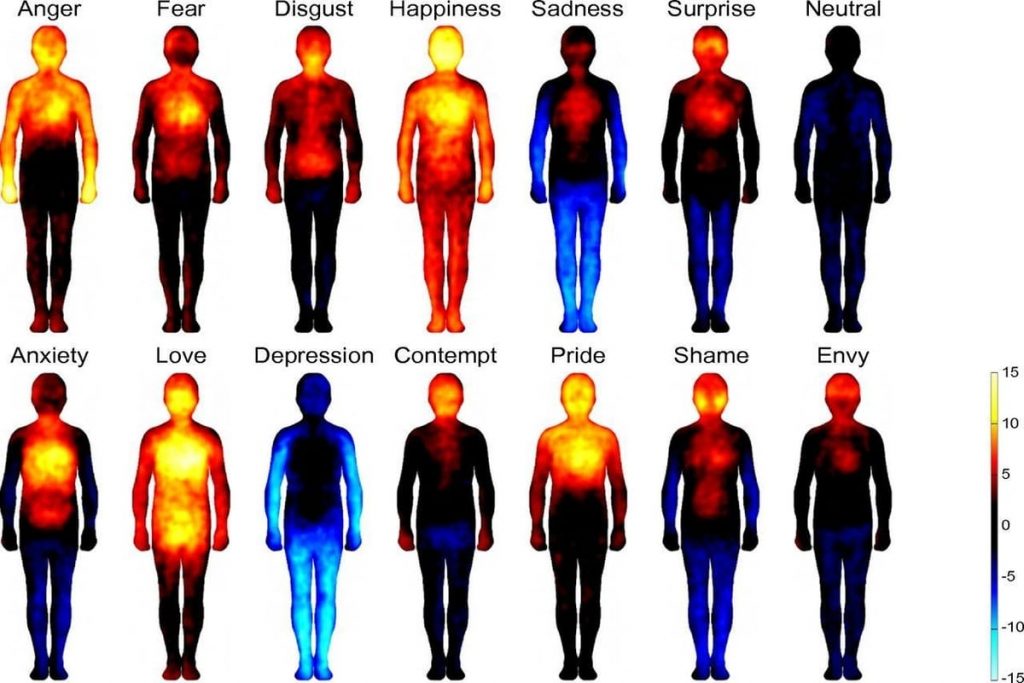This Is Where Emotions Are Stored In Our Body (Why Knowing This Matters)

When we are nervous, we often catch ourselves saying, “I have cold feet” or when you feel uncomfortable, you react by saying, “I have a gut feeling”. Many people don’t put much emphasis on these words, however, these simple phrases carry more weight than you imagine.
This is where emotional body mapping comes. Just how depression and anxiety can cause a physical reaction, emotions manifest in the body as well. You can feel the emotions in different parts of your body.
Our body is a central point where our emotions meet and are responsible for all important functions including cognitive and emotional functions. So, the next time you experience “cold feet” or “butterflies in your stomach”, don’t ignore them.
In this blog, let’s take a look at how body mapping emotions work and how our body parts and emotions are related to each other.
Body Mapping: How Does It Work?
First things first, to help categorize your emotions you can use this tool – Emotion Wheel. This wheel of emotions can help you better understand how and what you are feeling at the moment. Another option is to use body mapping activity. The accuracy of these tools, however, depends from person to person.
While the evidence on emotional body mapping is limited, it can still be used to communicate with your body to understand where your emotions are stored.
Where Emotions Are Felt In The Body?

Image credit: National Academy of Sciences. Bodily maps of emotions by Lauri Nummenmaa, Enrico Glerean, Riitta Hari, and Jari K. Hietanen
As I said, the research on emotional body mapping isn’t much but according to an expert, Enrico Glerean, there are 13 emotions and the body parts where they are stored. Let’s take a look at them:
1. Happiness
The emotion of happiness is stored throughout the body. So when you feel happy, you feel it in all the parts of your body.
2. Love
When you feel the emotion of love, your entire body is affected. However, the reaction may not be much in the legs.
3. Anxiety
When you feel anxious, the area above the pelvis, excluding the arms, feel more reactive and you feel a lower reaction in the arms, legs, and feet.
4. Depression
When you’re depressed, the body sensations in your lower body and arms are decreased.
5. Contempt
Contempt is mostly stored in the head and hands. If you feel this emotion then you’ll experience a decreased reaction around the pelvic and legs.
6. Anger
Anger is stored in the upper body and arms with a slight sensation in the legs and feet.
7. Fear
Fear is felt in the upper half of the body minus the arms. The reaction to fear in the body is similar to anger.
8. Disgust
Similar to the above two emotions, when you feel disgusted, you can experience a strong sensation in the upper half of your body.
9. Sadness
Sadness is registered in the lower body so when you feel sad, you can experience a lower reaction in your legs, feet, and arms. And a slight sensation in your chest and head.
10. Shame
The torso and head are affected by this emotion. You can also experience a decreased sensation in the arms, legs, and feet.
11. Pride
Pride is a warm emotion so when you feel proud, you can experience body sensations in the head, torso, and arms.
12. Envy
Envy is mostly stored in the head and chest. You can also experience a decreased sensation in the legs when you’re envious.
13. Surprise
Surprise is also stored in the head and chest. Similar to envy, you can experience a slight sensation in the legs.
Note: Mapping body sensations associated with emotions and physical reactions can help in better understanding emotional processing and recognizing mood disorders.
Why Expressing Emotions Matter?

Being connected with your mind and body is an integral part of your wellness. Ignoring or blocking emotions can make you more prone to illnesses and disorders. And I understand that sometimes expressing negative emotions may cause you to feel ashamed but you need to understand that there is nothing wrong with expressing negative emotions.
Not expressing emotions can manifest as physical aches and pains in your body. Understanding how emotions affect your body can help you process your emotions and identify disorders including mood disorders and depressive disorders.
The emotional body map should not be used as a substitute for an official diagnosis though. The body map can only help you identify emotions but remember that what feels right to you may feel different to others and vice versa.
If you’re unsure, it is strongly recommended that you seek out a professional diagnosis from a mental health professional only.For example, you can feel happy because you’re feeling positive while others may only feel contentment. Similarly, anxiety can either make you want to flee or can make you want to hide.
Somatic therapy can help you! In somatic therapy, you don’t focus on analyzing your feelings but are encouraged to feel and experience them. Instead of naming the feelings, you focus on the energy of the sensations and allow the release of the energy through your body.
Tips For Emotional Release

Some emotions are too subtle to describe but to feel the emotion, you need to name them. To do this, first, you need to slow down and do a body scan. Tune in with your body and pay attention to the increased sensations to describe the emotion.
Here are some steps you can take to ground your body and focus on the sensations:
- Move your feet and arms or rub them gently. Notice the sensations that run through your body.
- Find some object and take time to notice the texture, the smell, the color, or the feel of it.
- Take the time to look around the room and take in every small detail you see.
You can also try some somatic exercises to release stuck emotions. According to a licensed clinical worker, Hilary Hendel, when one emotion is dominating your body, say nerves in your stomach, you can decrease the sensation by lying face down (on your stomach) in a dark room and practicing belly breathing.
Deep breathing or belly breathing can stimulate the vagus nerve, the nerve that is triggered by emotions. When you practice deep breathing, it helps you calm down. You can start to feel the effect after five or six deep breaths.
Once you’re practicing breathing, you can take this time to gently and compassionately identify and name the emotions coursing through your body. Take this time to be aware of your feelings and emotions.
Other than deep belly breathing, you can practice grounding techniques such as putting your feet firmly on the ground and feeling the texture of the floor beneath your feet. You can also try other grounding techniques to help your brain calm down.
I hope this article helped you understand how emotions manifest in the body and where emotions are stored in the body. Do use this body mapping to know where you feel emotions in your body. Let us know in the comments below what you think about mapping body emotions.
Until next time, take care, and stay safe!




















